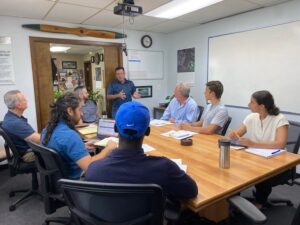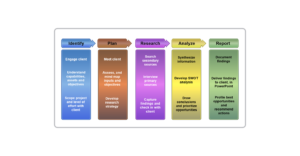By Cindy Matsuki, Small Business Innovation Research Program Manager for INNOVATE Hawaii, which is part of the NIST Manufacturing Extension Partnership (MEP) National Network
Polaris MEP is the Rhode Island Center for the MEP National NetworkTM, whose mission it is to strengthen and empower small and medium-sized manufacturing companies in the United States.
Technology-driven market intelligence (TDMI) is a technology acceleration service developed for the MEP National Network™ by RTI International to help small and medium-sized manufacturers refine their strategic direction and market validation.
This helps firms stay competitive and grow their businesses. Gathering market intelligence can be daunting, especially since you are not just looking at recent trends, but attempting to determine where the market is headed.

Market research and a proper TDMI assessment require significant time and expertise you may not have in-house.
Your local MEP Center, like Polaris MEP, has access to internal and third-party experts who can deliver this service. It has the experts that can gather, sort, and analyze data on your customer preferences, competitor activities, and technological advancements.
The TDMI Lite model
INNOVATE Hawaii (the Hawaii MEP Center) and RTI developed a streamlined approach to TDMI as part of wraparound services for federal Small Business Innovation Research (SBIR) companies. In this blog, we’ll look at the TDMI Lite model and its focus on a preliminary assessment and value propositions.
The preliminary assessment puts a significant focus on the value proposition, which is a great starting point for any company looking to grow its business. Innovate Hawaii and RTI work with SBIR recipients to help them:
- Articulate their value proposition.
- Identify potential dual-use markets (can be used for both civilian and military applications) to investigate.
- Assess one or two selected markets.
- Test and refine the initial value proposition.
- Provide strategic insights.
The SBIR recipients, all of whom received various matching state and federal funds, included companies from the defense, energy, and agriculture sectors.
What is the value proposition assessment and why can it be valuable for Rhode Island Manufacturers?
The drivers behind TDMI include technology, market possibilities, and a comparison with competitors. There are two primary components:
1. Capabilities and needs assessment The process is conducted by engineers and scientists and begins with a deep study into your company’s unique technology and technical capabilities.
The process is conducted by engineers and scientists and begins with a deep study into your company’s unique technology and technical capabilities.
This is used to articulate your hypothetical value proposition, which will be tested in the research. Other strengths and limitations are also explored.
The assessment seeks to understand your key needs. For example, are you most interested in market size, competitive companies and their technologies, partners, or entry strategies? Or some combination of these? Do you already know which markets you want to explore or do you want the research to identify them? What does a successful project look like? How will you act on the results?
2. Market intelligence
This information helps you understand whether opportunities exist in the markets explored. If the answer is yes, it also provides insight about which markets are most promising and how you should pursue them.
Working on your value proposition will help you envision the near future in multiple ways. Looking at your competitors will help you sharpen your value proposition – either by selecting markets where you have an advantage or avoiding markets where you don’t.
Market intelligence is crucial to align with needs and opportunities
 Market research can help you test assumptions and provide a reality check to see if there is any traction. You can use direct market research, such as voice-of-customer interviews. In addition, you can use secondary market research, which has already been compiled by other sources.
Market research can help you test assumptions and provide a reality check to see if there is any traction. You can use direct market research, such as voice-of-customer interviews. In addition, you can use secondary market research, which has already been compiled by other sources.
Assumptions are often based on observations in a controlled setting. This makes customer input extremely valuable because customers put solutions to use in real-world settings influenced by many other variables.
Sometimes the research and feedback validate an opportunity. Other times they reveal that an opportunity was not viable – saving you time, money, and other resources. Research and feedback can also show you how to adjust your value propositions, identify a different set of prospects to call, or even pivot your offering.
It is important to find the right partners to help you with market intelligence. Look for experts who offer:
- Knowledge about new markets with customers that you don’t have experience working with.
- Breadth of experience – in technologies and applications – which can lead to ideas for new market opportunities.
You also want to work with experts who can tap into the experience of multiple networks. For example, RTI works with the Polaris MEP and the entire MEP National Network, Manufacturing USA institutes, and national laboratories. That’s an incredible amount of technical expertise to draw on.
How the value proposition process works
An innovator has an initial motivation to solve a problem – leading to a narrow focus on a specific pain point. That same solution might apply to a much larger set of applications or could go to market more quickly.
Many startups fail because they do not get the market research that could have steered them away from failure and toward success. The most common reasons for startup failures are no market need, a flawed business model, or an inability to compete.
David Tohn, CEO of Maryland’s BTS Software Solutions, said TDMI helped them “avoid wasting time and resources where there was a low likelihood of success.”
 Your value proposition has many elements, and those can be tested separately with market research to validate or identify flaws. You can build a customer profile of characteristics that you assume, observe, and verify in the market. Your value proposition should articulate how you will attract customers.
Your value proposition has many elements, and those can be tested separately with market research to validate or identify flaws. You can build a customer profile of characteristics that you assume, observe, and verify in the market. Your value proposition should articulate how you will attract customers.
Products and services must offer solutions for the customer. Ask yourself how your offerings:
- Help the customer do their job more effectively?
- Align with customer challenges – and potential gains?
Examples of manufacturer success with the streamlined TDMI process and support from their MEP Center
The streamlined TDMI approach delivered tangible results for the SBIR participants, helping them compete for new and more lucrative business. Here are two examples:
- Nalu Scientific designs mixed-signal integrated circuits for applications in particle tracking and time-of-flight measurements – a niche called application-specific integrated circuit (ASIC).
 The TDMI project identified new areas for Nalu to pursue with its technology, including light detection and ranging (LIDAR), which uses lasers to measure time and distance. Nalu ended up winning SBIR grants from NASA and the National Oceanic and Atmospheric Administration to design LIDAR ASIC applications.
The TDMI project identified new areas for Nalu to pursue with its technology, including light detection and ranging (LIDAR), which uses lasers to measure time and distance. Nalu ended up winning SBIR grants from NASA and the National Oceanic and Atmospheric Administration to design LIDAR ASIC applications.
- Orion Entrance Control is a global provider of optical turnstiles for facilities that require security and oversight of traffic coming in/out of their spaces. They partnered with another company to develop a product with defense applications, but needed a framework on how to research the opportunity and turn it into a viable product.
Leveraging TDMI through the New Hampshire MEP, they discovered and assessed applications and markets for specific capabilities for both defense and commercial sectors. The research allowed them to pair potential applications down to one or two worthy of further exploration, and ultimately identify and prioritize potential customers and partners.
- Simonpietri Enterprises’ Aloha Carbon concept diverts construction and demolition waste from landfills and converts it via gasification to sustainable fuel and green hydrogen.
The company began work on how to enter the aviation fuel market. Its TDMI project tested the value proposition with investors and substantiated the markets. Simonpietri won a competitive phase two award from the Department of Agriculture for its innovations to make renewable jet fuel that is cost-competitive with petroleum. This is a big win, as the Hawaii economy relies heavily on aviation, and the state is running out of landfill space.
Polaris MEP, Rhode Island’s local MEP Center, can help you with Technology Driven Market Intelligence

NIST MEP Technology Driven Market Intelligence (TDMI) Process, Tools & Deliverables
A technology-driven market assessment can help you refine your strategic direction and market validation to stay competitive and grow your business.
Think of it as the intersection of market intelligence – telling you what will happen – with an assessment of your capabilities and needs.
Polaris MEP can help you with a TDMI assessment to test your value proposition and think about your future in new ways. Click here to schedule a conversation about your needs and goals.
